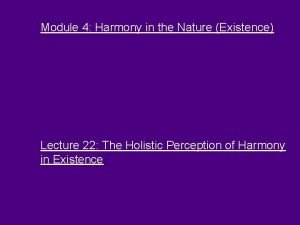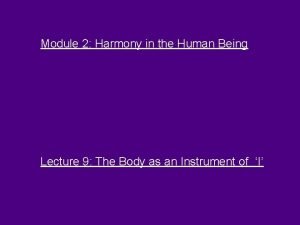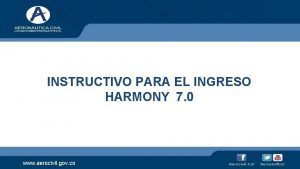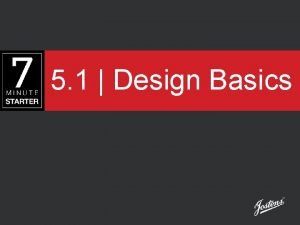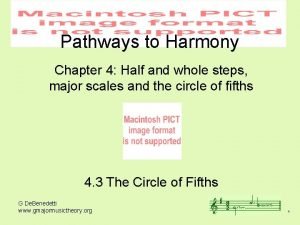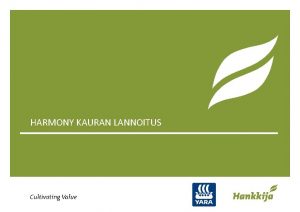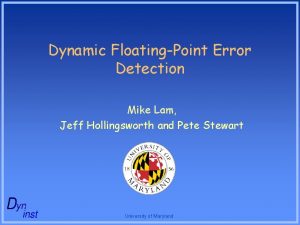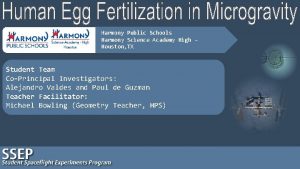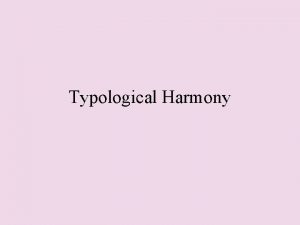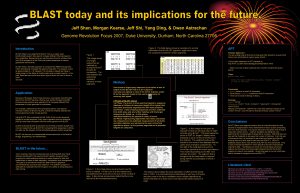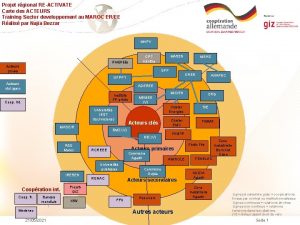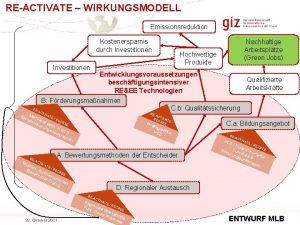ReActivate Harmony Philip Yang Jeff Hollingsworth phics umd



















- Slides: 19

Re-Activate Harmony Philip Yang Jeff Hollingsworth phi@cs. umd. edu University of Maryland, College Park 12/5/2020 1

Outline • • • Active Harmony review Software design Experiment result Future work Q&A 12/5/2020 2

Motivation • Program can be transformed by changing • Template parameters, user flags • Loop unrolling, tiling • Threads distribution, SIMD • Transformation interactions are complex • Unrolling can affect tiling by change memory access pattern • Tiling may limit ILP (Instruction Level Parallelism) • Static analysis alone can’t capture all these • Exhaustive search is too expensive 12/5/2020 3

Our Approach • Parallel Rank Ordering (PRO) • • • Unconstraint optimization Tunes the program while it is running Utilizes parallelism for parallel program Gives good initial performance Quickly approaches optimal configuration • The core of Active Harmony 12/5/2020 4

PRO Search: Input • Simplex of k. N vertices • • • vertices in N-dimensional parameter space k. N = #processor Performance Measurement Function • • • Smaller value reflects better performance Time, error, etc. Projection to parameter space • Force constraints 12/5/2020 5

PRO Search: Simplex Maintain simplex 1. 2. 3. Measure Proj{original} Measure Proj{reflect} IF min(reflect) < min(original) 1. Measure Proj{expand} 2. IF min(expand) < min(reflect) 1. Accept expand 3. ELSE 1. 4. Accept reflect ELSE 1. Accept shrink 12/5/2020 6

PRO Search: Convergence • Termination Criteria • Simplex collapsed to a single point • We reached max number of iterations • Sensitive to initial simplex • Empirically, terminates pretty quickly • If is continuously differentiable, 12/5/2020 7

System Design Goals • Portability • Core components in C++ and Python • Minimize dependencies • Loosely coupled modules • Change the search algorithm without affecting the rest • Dynamically load CUDA code via JIT • Code server compiles. cu to. ptx, assembly file for CUDA • Use CUDA Driver API’s JIT engine • Visualization 12/5/2020 8

System Architecture PRO Search Harmony Server Projection Function Visualization C/Fortran code_gen CUDA run_time CUDA JIT 12/5/2020 9

code_gen • Many transformations require recompilation • Recompile the code to dynamic libraries and load them while running • For CUDA • • Use nvcc to compile. cu to. ptx Load. ptx at runtime with JIT provided in the CUDA Driver API 12/5/2020 10

code_gen: CUDA JIT #include "code_gen. h” int main(int argc, char** argv) { CUdrv. Base driver; driver. init(argc, argv); // initialize device driver. load("simple_kernel. ptx”); // load ptx code // Initialize data … // launch kernel cu. Launch. Grid(driver. get. Kernel(), num_blocks, num_threads); 12/5/2020 11

code_gen: CUDA JIT 12/5/2020 12

run_time CUDA JIT sys/dyld Harmony Server run_time PROJIT Search CUDA JIT sys/dyld Projection sys/dyld run_time Simplex run_time CUDA JIT Source Code CUDA JIT Code Server CUDA JIT sys/dyld. c / f sys/dyld gcc sys/dyld nvcc . so . ptx . cu 12/5/2020 13

Visualization 12/5/2020 14

Experiment • PRO Convergence Test • Randomly initialized Simplex size = 40 * dim(X) • Random initialization of simple Dimension / function • CPU Poly deg=10/ 2 3 4 5 GPU hybrid 22 BLAS dgemm 22 22 Sin(sum(X)) 23 • Tesla 2050 22 22 cores (Fermi)23 GPU + 8 Xeon Sin(X^2) 23 • Lots of 21 parameters 24 to tune 21 20 12/5/2020 15

Experiment: DGEMM • GPU: 295 GTX, CPU: 8 Xeon cores • Parameters: • • Array padding Activate page-locked memory Splitting Matrix A or B How much to split to GPU Performance original harmonized Speed up 89 GFLOPS 145 GFLOPS 1. 63 x 12/5/2020 16

Future Work • Improve search algorithm • Adaptive step size for PRO • Harmonize harmony • Statistical learning approach • Different code might utilize different search strategies • Predict the performance • Performance Energy trade-off • Game theory: Nash/Stackelberg Equilibrium 12/5/2020 17

Q&A 12/5/2020 18

Thank You Philharmonic Harmony 12/5/2020 19
 Swibż
Swibż Dr jeffrey hollingsworth
Dr jeffrey hollingsworth National haemoglobinopathy registry
National haemoglobinopathy registry Haemtrack login
Haemtrack login Harmony synel
Harmony synel Calm personality
Calm personality I harmony
I harmony Holistic understanding of harmony on professional ethics
Holistic understanding of harmony on professional ethics Holistic perception of harmony
Holistic perception of harmony Harmony in human being
Harmony in human being Metron harmony
Metron harmony Harmony of self with the body
Harmony of self with the body Harmony is normal and conflict is abnormal
Harmony is normal and conflict is abnormal Dpc+
Dpc+ Design principles contrast
Design principles contrast Ano ang harmony
Ano ang harmony Harmony hui
Harmony hui Pathways to harmony chapter 1 answers
Pathways to harmony chapter 1 answers Harmony nhcs
Harmony nhcs Bashar krayem
Bashar krayem








